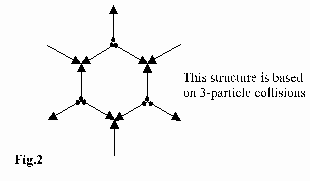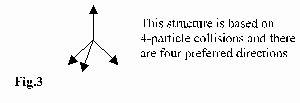
4.2 Qualitative description of the structure
The term "structure" means an arrangement that can be either chaotic disordered or geometric.
The attribut of particles being alike and moving with speed of light can be shown as follows:

The arrows indicate the direction of movement of the particles. Each of the particles has a certain space.
This drawing (Fig.1) represents the situation in open space. A proton, an electron or even a black hole are to be described by different drawings.
An orderly structure can be established by repeated collision of particles. They move between the collision points to and fro.
A more or less stable structure in the plane is imaginable for exampel by hexagons (Fig.2):

A more or less stable structure in space is imaginable by tetraeders, like a diamond (Fig.3):

In order to remain those structures relatively stable outwards it is essential that those structures be supported by the surrounding structure, even if this structure is chaotic.
Obviously, this is only possible in a dynamic internal structure. The internal structure is in a balance with the surrounding and permanently changing chaotic structure.
Consequently, the electrons of hydrogen in space have to "rely" on the surrounding structure.
Now to the structure of light:
In the variety of directions of particles presented in figure 1, you can certainly find such particles, a photon or a part of a "electromagnetic wave" consists of. Such a group of particles is characterized by the wave-length of the "electromagnetic wave". The wave-length is defined as the spacial distance between two equal points, whereas in between everything is unequal to these points. Two particles moving in the same direction would already meet this condition in the chaotic space corresponding to the figure 1. The "electromagnetic waves" originate from a non-chaotic structure. As they can also be absorbed by such a non-chaotic structure , the wave-length should orientate itself on such non-chaotic structures. For this at least three particles are needed on a plane non chaotic structure. In the following such a structure-capable formation will be named "l" and it consists of three particles (Fig.4):
